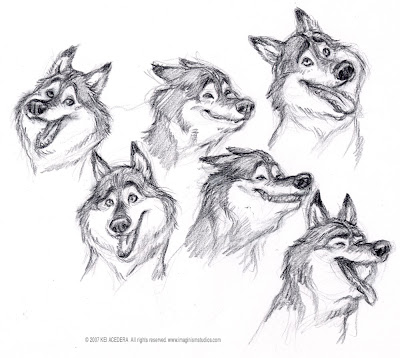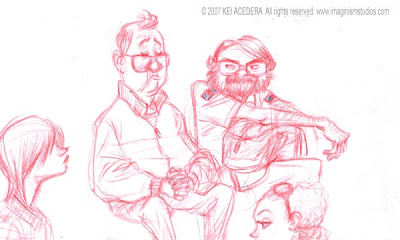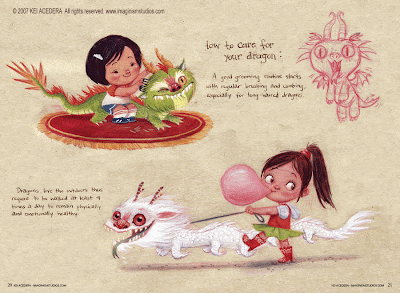KEI ACEDERA INTERVIEW
Character Designer
Saturday, December 22, 2007
BROUGHT TO YOU BY THE CHARACTER DESIGN BLOGSPOT
IF YOU WOULD LIKE TO SEE MORE INTERVIEWS GO TO THE HOME PAGE AT CLICKING HERE
THE INTERVIEW

Tell me a little bit about yourself, about your life? Where did you go to school, and what classes did you study? What helped prepare you to become the artist that you are today?
I was born and raised in the Philippines and came to Toronto, Canada when I was 12. I started my career at about 16, when I was hired to help paint huge murals for private homes (most were the size of mansions!) and casinos. That experience really helped me develop my painting skills. Then two years later, thanks to Chuck Gammage, I got my first break in animation doing in-betweening and clean-up. It was a great opportunity for me to really learn more about the animation industry.
In terms of formal training, I went to Sheridan College for Animation, where I met some terrific, gifted people who helped me become the artist that I am today. Perhaps the most influential of these individuals was Bobby Chiu. He saw potential in my art and invited me to come work with him at a little company he’d just started called Imaginism Studios.
We didn’t know where the studio was headed, we just tried to keep drawing and painting, and luckily, once we started to publish our “Sketches” series of art reference books, people started to notice our illustrations. We won a few awards and soon the projects started coming in. Since then, we’ve worked on designing characters for all sorts of things from TV shows, to videogames, magazines, advertising, and commercials.
How do you go about designing a character, and what goes through your mind, from start to end?
I believe that our personalities, our work, our history, etc. all translate into how we look. Therefore, when I go about designing a character, I always start by trying to fully realize who the character is, what their personality is like, and what are they going through? Then I try to visualize them in a variety of situations, and really picture them moving around and living lives. Then I draw variations of the character, while still keeping in mind the kind of emotion I want to convey. I experiment with everything--shapes, shadows, lines--to find what look and design best suits the character. If at this stage I’m still trying to figure out what the character looks like, I draw light and loose. If I already have a strong, clear idea in mind, I draw faster and with more sure, solid lines.
What is a typical day for you?
I start with morning drawing warm-ups with the gang in the studio. These are random sketches from life, from memory and from photos or films. We all do this because we believe if you start drawing first thing in the morning, you’ll have a good drawing day. It’s just like working out. Then we have studio meetings to discuss ideas and how we’re progressing on our projects. If we’re not on a tight schedule, we might then go to the gym (in which case, our studio meeting might take place in the Jacuzzi!). Then for the rest of the day, we work on our projects until whenever we feel we should stop. (Typically, that means around 1:00 a.m.) It’s a really great environment; Bobby even encourages us to take power naps to keep ourselves refreshed and energized, which is vital to maintaining our effectiveness throughout the day.
What are some of the things that you have worked on?
We’ve been publishing our own “Sketches” series of books for two years now. We just released the eighth book, “Dragon Sketches”. I’ve worked recently on a couple of TV shows but they are presently in the middle of production so I can’t say which ones right now.
I also recently designed the Marshmallow and Holly mascots for Borders Bookstores’ holiday campaign, which you can see at any Borders store in the US. No big movies yet for me although I’d love to work on one someday.
Is there a character design you have done that you are most proud of?
Hmmmn…There are some that I do like such as my kids and women characters, but still, I feel like I’m constantly growing and learning, and there are always things that I’d want to change! Ask me again when I’m 80.
What projects have you done in the past, and what are you working on now? (If you can tell us)
I’m currently working on a TV show that’s being produced by an Oscar-winning actor that I cannot name yet. And I’m working on my very own children’s book. I also like making short animated films and would like to get back into that soon.
Who do you think are the top artists out there?
There's so much amazing work being produced these days, it's hard to narrow down a list, but some of my favorite artists include Erich Sokol, Sargent, Henrich Kley, Bill Peet, Milt Kahl, Lou Romano, Tadahiro Uesugi, Peter de Seve, Carter Goodrich, Nicholas Marlet, Chris Sanders, Ben Balistreri, Bill Presing, Robert Valley, Alberto Ruiz, Stephen Silver and Bobby Chiu!
Could you talk about your process in coloring your art, as well as the types of tools or media that you use?
I’ve used almost everything, but lately I've been working primarily in Photoshop and Painter, plus some inks and gouache for traditional work. But any regular pencil or paper is fine with me too. I love traditional media just as much as digital; I think maintaining my traditional roots help my digital painting a great deal.
I usually start off with loose drawings, trying to feel out that idea in my head. Sometimes it comes out more vividly and I’ll have a tighter, more solid drawing. Then I’ll paint it traditionally, digitally, or a combination of the two, depending on what kind of look I’m going for.
What part of designing is most fun and easy, and what is most hard?
Drawing and designing is fun and easy; the hardest part is getting approval from either the client or in most cases, from yourself.
What are some of the things that you do to keep yourself creative?
I do a lot of different things to keep myself creative. The first thing I do is try to surround myself with creative people because, believe it or not, creativity rubs off. I like to listen to other people’s ideas and learn how they think. Then when I need an idea, I can try their creative tricks in addition to my own.
I also like to immerse myself in books, magazines, and films, for ideas and inspiration. I love looking through really old books and pictures--the best are from my own family or from second-hand bookstores! But I think the best thing to do to stimulate the creative process is traveling because imagining new places is nothing compared to actually GOING to new places! Through traveling, I’ve seen things that I could never have come up with on my own.
What are some of your favorite character designs which you have seen?
I love Erich Sokol and Chris Sanders' characters! Sokol has a "rawness" in his style, which I love—his lines, his strokes are just sheer genius! And Sanders has this cute, round softness in his designs that is just irresistible!
My absolute favorite character designs are from Disney’s "The Jungle Book" and “Robin Hood". Those characters are classic and timeless. I still watch those two films over and over again and I would spend hours rewinding, playing and pausing because each frame is a masterpiece.
I'm also a huge fan of Peter de Seve and Carter Goodrich's illustrations from "The New Yorker". These artists' designs are not only visually appealing, they are also humorous and witty. I feel the hardest part about character design is installing personality and life into a character, which is what makes doing so a hallmark of a great designer.
What is your most favorite subject to draw? And why?
I enjoy drawing just about any kind of character as long as I can breathe some life into the design. I love to draw cute little kids and animals because they carry an innocence in their expressions and postures that is very honest and instantly endearing.
What inspired you to become an Artist?
Oh, too many things! Every illustrated book I picked up as a little girl—from DaVinci to Sargent to Sasek—inspired me to become an artist. Art is an incredible way to express yourself and share yourself with the world. I dreamed that one day, a little girl somewhere would pick up a book with MY drawings in it and become an artist too when she grows up. Creativity begets creativity and from those art books, I knew early on that I wanted to be a part of that process. I was also very lucky to have parents who supported me in anything I wanted to do. Growing up, my mom made sure I always had a sketch pad and pencils with me wherever I went.
What are some of the neat things you have learned from other artists that you have worked with or seen?
There is no such thing as talent; there IS, however, such a thing as passion and hard work. If you really want it, you can get it.
What are some of your favorite websites that you go to if you have the time?
Here are some great art forums I try to go to once a while: cgtalk.com, drawingboard.org and conceptart.org.
What wisdom could you give us, about being an Artist? Do you have any tips you could give?
The thing I’ve discovered over the past years is that there’s a big difference between being able to draw and being an artist. Drawing is just an ability to do something, whereas being an artist is a definition of self. If you want to truly be an artist, you must be obsessive and passionate about art. Being able to draw is just the beginning.
If people would like to contact you, how would you like to be contacted?
You can contact me through my studio site: www.imaginismstudios.com or my email: kei@imaginismstudios.com
Finally, do you have any of your art work for sale (Books, sketchbook, prints, or anything) for people that like your work can know where and when to buy it?
Prints of my work and our “Sketches” series of books are available at our studio website, www.imaginismstudios.com. We also tour conventions in the northeast and Midwest USA and California in the summer, in addition to shows in our hometown of Toronto so if you’re in the neighborhood, drop by and say hi!
Subscribe to:
Comments (Atom)




























